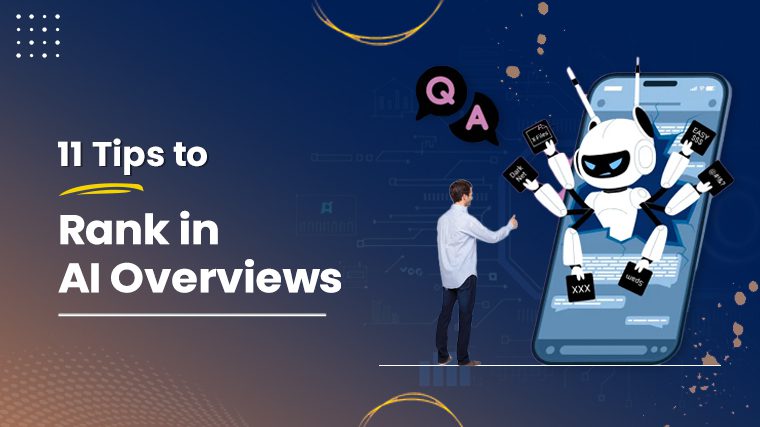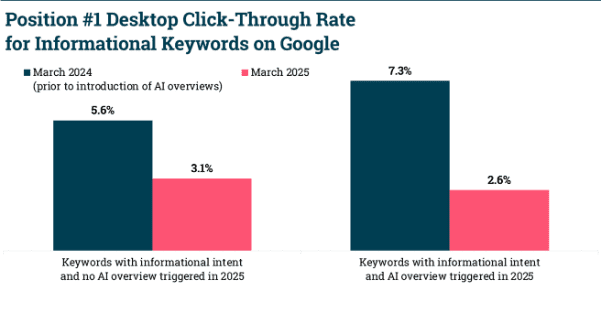
In the face of rapidly changing trends, the world of digital marketing is afoot with the innovations brought in by AI and SEO, fundamentally altering how to rank content on search engines like Google. With Google launching AI Overviews, optimized for visibility, this new generative AI-powered search experiences should definitely be on the radar. AI Overviews offer brief, AI-generated answers at the very top of the search results, often gathering information from many different sources for quick insight. For any business or content creator, getting ranked in these overviews can pull huge traffic.
AI Overviews Are Slashing Click-Through Rates
As shown below, click-through rates for position #1 have significantly dropped when AI Overviews are triggered—reinforcing the need for businesses to adapt SEO strategies that go beyond just ranking high.
The following list comprises 11 action points that can help AI Overviews refine your content and avail SEO elevation.
- Familiarise Yourself with AI Overviews
AI Overviews summarize the pertinent information from the pages that rank at the top of Google. Your content must be authoritative, topical, and easy to skim for Google’s AI to deem it worthy. AI seeks concise and trustworthy sources. Focus on producing great content that directly answers the questions of users.
- Optimize for Featured Snippets
In many cases, AI Overviews draw their input from featured snippets. All the content must be presented clearly in head sections, and in bullet points. Answers to frequently asked questions should be provided in a concise manner. It is advisable to include schema markup to make content ranked under featured snippets since Google’s AI relies heavily on well-structured data to create overview information.
- Accent User Intent
Google’s AI explicitly pays attention to content that mirrors user intent. Use what users ask by analyzing “People Also Ask” sections and long-tail keywords. Address those questions directly while ensuring that your content is holistic yet easy to digest.
- Use Structured Data
Structured data such as JSON-LD will give meaning to the context of your content so that Google’s AI can understand it. You should apply schema types such as FAQ, How-To, or Article to enable your content for AI. By doing so, you will increase the chances for AI Overviews to feature your content.
- Create Great Original Content
AI Overviews often prefer authoritative original content. Avoid duplicate and shallow content–go for depth, research, and consideration. For example, a high-authority source like Search Engine Land itself states that expertise in content creation is important for its SEO success.
- Use Clear and Concise Language
Readability goes a long way in determining which content gets more attention from Google’s AI. Opt for writing very short sentences. No jargon. Bullet points or lists like this will also work wonders. The Hemingway Editor can do a great job ensuring that your content does not score poorly on inclusivity.
- Optimize for Long-Tail Keywords
Long-tail keywords such as “SEO optimization AI tips for small businesses” are aligned with specific queries that AI Overviews target. Use these naturally throughout your copy, especially in headings and the introduction, to enhance relevance.
- Build Topical Authority
Your site should be established as the go-to resource through the creation of content clusters around a given topic. For example, the SEO agency USA could publish a series of guide articles on AI-driven SEO strategies, linking related articles to send signals of expertise to Google’s AI.
- Improve E-E-A-T (Experience, Expertise, Authoritativeness, Trustworthiness)
E-E-A-T takes precedence for Google’s AI. Make sure that the author bios prove expertise, cite credible sources, and link to reputable sites. Testimonials and client case studies can go a long way toward enhancing the trustworthiness of SEO services USA.
- Frequently Monitor and Update Content
Any given topic in AI Overviews is fresh. Updating articles regularly will include some of the latest topics, trends, statistics, or changes to algorithms. Monitor your site using Google Search AI Console to keep track of its performance and find opportunities for improvement.
- Analyze Competitors
Look into competitors ranked within AI Overviews. Break down the competitor’s content structure, their keyword usage, and also their backlink profile. While doing this with tools like Ahrefs or SEMrush, one should clearly see the gaps in their own strategy and tactics they can replicate from their partners.
| Aspect | AI Overviews | SEO Strategy |
| Purpose | Summarize key info using generative AI | Improve visibility in organic search results |
| Ranking Factor | Content relevance + authority + structured data | E-E-A-T, keywords, backlinks, user experience |
| Content Format | Concise, factual, conversational summaries | Optimized blog posts, FAQs, how-tos, schema-rich content |
| Optimization Focus | Featured snippets, authoritative sources, FAQs | Long-tail keywords, structured content, topic clustering |
| Best Practice | Align content with user intent + semantic search | Use natural language, FAQs, schema markup, and strong linking |
Conclusion
Ranking in AI Overviews is a function of a fine-tuned merger of good, high-quality content, technical optimization, and a huge understanding of user intent. Implementing these 11 tips can give businesses and content creators enough leverage to increase visibility in Google’s AI-driven search space. Anyone seeking professional help can consult established experts like e intelligence, India’s premier digital marketing agency, for personalized strategies to sail through the ever-growing competition in SEO optimization AI and create a footprint in the AI Overviews. Stay updated, keep brushing up on your methodology, and see your content rise like never before.
Rank in AI Overviews
AI Overviews are stealing the spotlight on Google. Follow these 11 practical tips to boost your chances of getting featured and staying visible.





